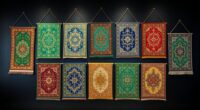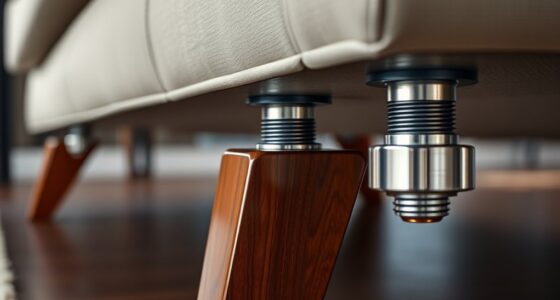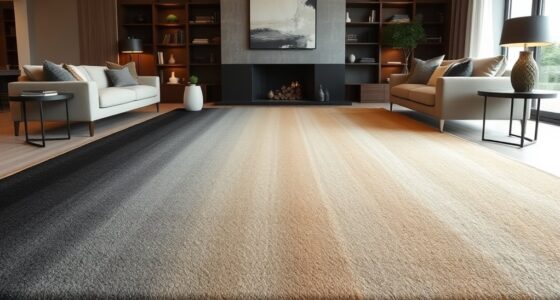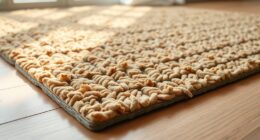I’ve reviewed the top HD digital microscopes for fiber inspection in 2025 and found options offering sharp images, high magnification up to 1600X, and clear video recording. Many models feature adjustable LED lighting, WiFi connectivity, and portable designs perfect for detailed fiber analysis. Whether you’re a professional or hobbyist, these microscopes deliver precise results. If you want to explore which models stand out and find the right one for your needs, keep exploring further.
Key Takeaways
- Top HD digital microscopes offer high magnification (50X–1600X) with 10MP–20MP cameras for detailed fiber analysis.
- Features include adjustable LED lighting, flexible illumination options, and high-resolution screens for clear imaging.
- Wireless connectivity via WiFi, Bluetooth, and USB enhances portability and allows real-time sharing.
- Durable, lightweight designs with ergonomic stands and rotatable screens improve user comfort and ease of use.
- Advanced focus controls and high-quality optics ensure sharp, precise images essential for fiber inspection.
Fiber Optic Inspection Microscope 400x LED Illumination Handheld

If you’re inspecting fiber optic cables and need a reliable handheld microscope, the Fiber Optic Inspection Microscope 400x LED Illumination Handheld is an excellent choice. Its 400x magnification reveals detailed features, ensuring accurate inspections. The bright LED illumination provides clear images, while the laser filter offers eye protection during use. With universal adapters for SC, LC, and FC connectors, it suits various fiber types. The anti-slip rubber grip makes handling comfortable, and focus control is smooth for precise viewing. Designed for portability, it’s perfect for fieldwork or lab settings, helping you achieve accurate, bright images every time.
Best For: technicians, field engineers, and fiber optic professionals needing portable, detailed inspection of fiber optic cables and connectors.
Pros:
- 400x magnification for highly detailed fiber inspection
- Bright LED illumination with laser filter for clear, safe viewing
- Universal adapters compatible with SC, LC, and FC connectors
Cons:
- Handheld design may require steady hands for precise focus
- Battery life depends on usage and may need frequent replacement or recharging
- Limited to optical inspection; not suitable for other testing functions
Fiber Optic Inspection Microscope with Adapter and Cleaner
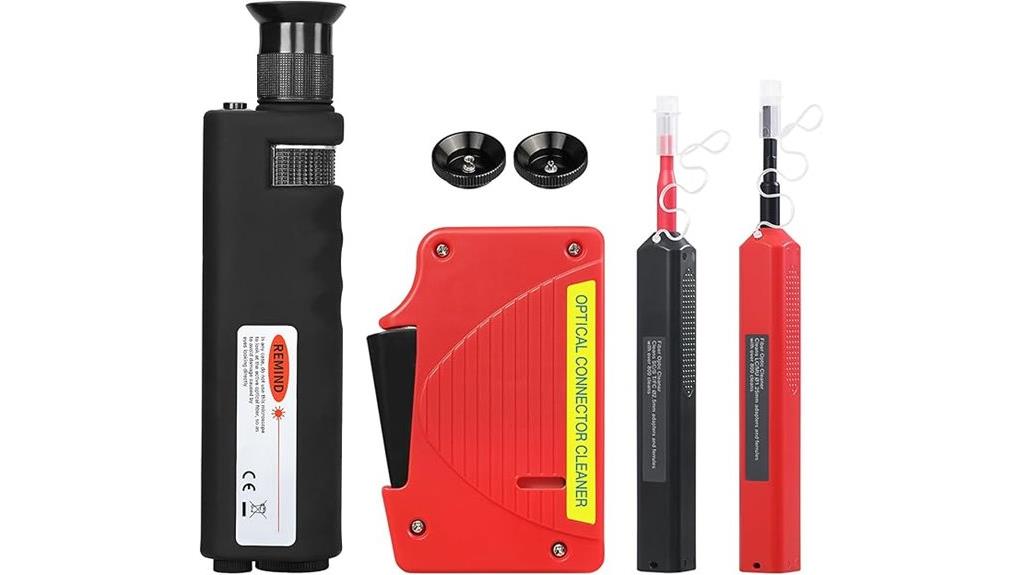
The Fiber Optic Inspection Microscope with Adapter and Cleaner is an excellent choice for professionals who need quick, accurate fiber end face inspections in both laboratory and field settings. It features dual adapters—2.5mm for SC, FC, and ST interfaces, and 1.25mm for LC—allowing versatile compatibility. Its plug-and-play design ensures easy operation, while the dustproof, waterproof build offers durability. The included handheld LED cleaner provides immediate fiber end detection without extra tools. Powered by 3 AAA batteries, it delivers real-time assessments of fiber conditions, making it ideal for on-the-go inspections. Compact and lightweight, it’s a practical solution for precise fiber analysis anywhere.
Best For: technicians and engineers who require quick, accurate fiber end face inspections in both laboratory and field environments.
Pros:
- Easy plug-and-play operation with dual adapters for versatile fiber compatibility
- Durable dustproof and waterproof construction suitable for various settings
- Includes handheld LED cleaner for immediate fiber end detection without extra tools
Cons:
- Some users may experience issues with focus and functionality according to reviews
- Limited to inspection and detection, not suitable for extensive fiber testing tasks
- Slightly higher price point compared to basic fiber inspection tools
Handheld Fiber Optic Microscope Inspection Tool with Adapters
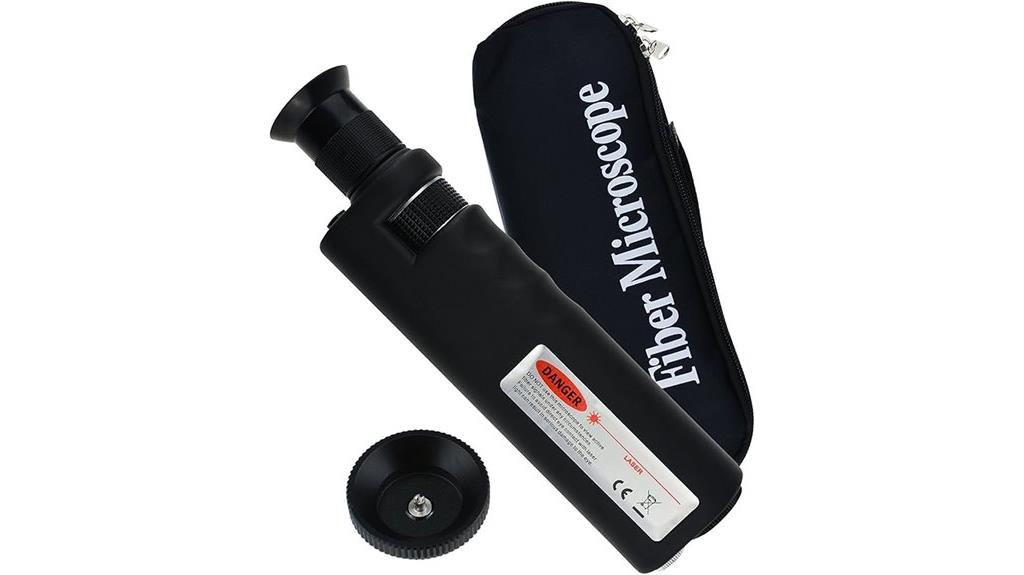
The Handheld Fiber Optic Microscope Inspection Tool with adapters stands out for its portability and versatility, making it an ideal choice for technicians and hobbyists who need quick, on-the-spot fiber inspections. With 400x magnification and built-in LED illumination, it reveals detailed views of fiber end-faces, dust, and connectors even in low-light conditions. Its compatibility with 2.5mm and 1.25mm adapters allows inspection of various connectors like FC, SC, ST, and LC. The non-slip rubber housing provides a secure grip, ensuring stability during use. Despite some calibration and alignment challenges, this lightweight device offers a practical, cost-effective solution for fiber optic inspection tasks.
Best For: technicians, fiber optic installers, and hobbyists needing portable, detailed fiber end-face inspection tools.
Pros:
- Offers 400x magnification with clear, stable images suitable for detailed fiber inspection.
- Includes versatile adapters for multiple connector types like FC, SC, ST, and LC.
- Compact, lightweight design with built-in LED illumination and non-slip rubber housing for enhanced usability.
Cons:
- Calibration and alignment of adapters can be time-consuming and challenging.
- Some connectors, such as MPOs, are not compatible, limiting versatility.
- Rubber housing may slip during use, affecting stability and ease of inspection.
Fiber Inspection Video Probe with HD LCD Display and Tips
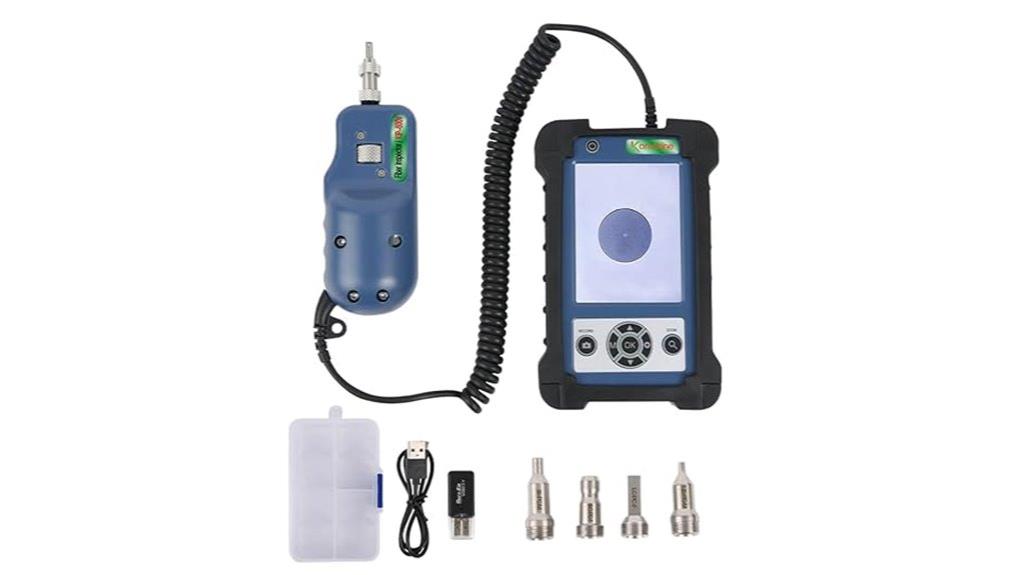
For professionals who need precise fiber inspections, the Fiber Inspection Video Probe with HD LCD Display and Tips offers exceptional clarity and ease of use. Its 3.5-inch HD screen provides real-time, detailed images of fiber end-faces at 400x magnification. The probe supports quick pollution checks on various connectors, including FC, SC, ST, and LC, with multiple tips for versatility. With a 1/3-inch sensor and 300,000 effective pixels, it captures sharp, high-resolution images for analysis. The device’s long-lasting 4000mAh battery guarantees up to 20 hours of operation, while data recording and playback capabilities streamline inspection workflows.
Best For: professionals requiring precise, high-resolution fiber end-face inspections in various network and telecommunications environments.
Pros:
- Offers 400x magnification with a high-resolution 1/3 inch sensor for detailed fiber analysis.
- Supports real-time video recording, data storage, and playback, streamlining inspection workflows.
- Long battery life of up to 20 hours ensures reliable use in extended field operations.
Cons:
- May be relatively expensive compared to basic fiber inspection tools.
- The device’s size and weight might be less portable for some users on the go.
- Limited to specific connector types and may require additional tips for specialized applications.
TOMLOV DM9 Max Digital Microscope
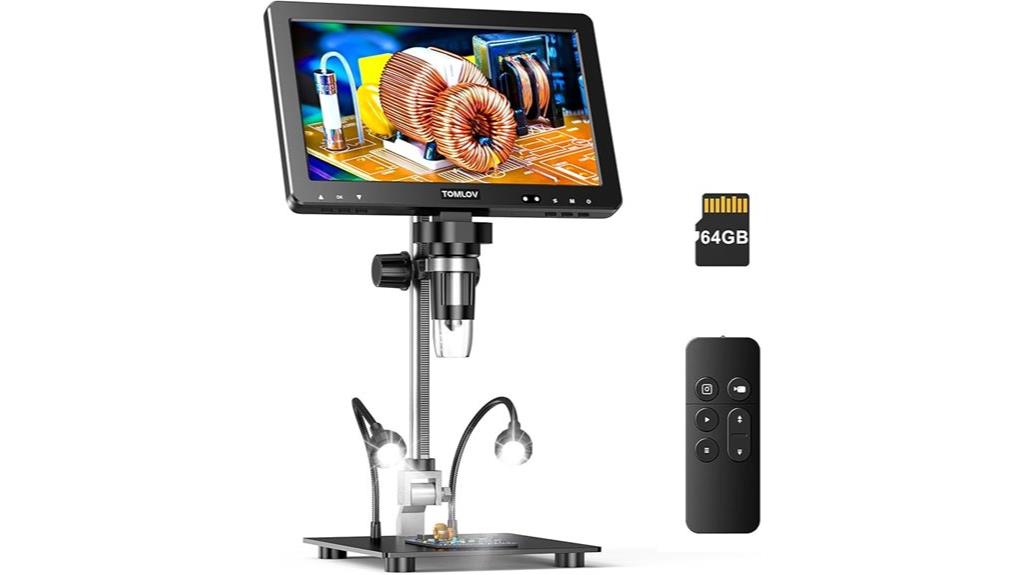
If you’re looking for a versatile digital microscope that delivers stunning image quality and easy connectivity, the TOMLOV DM9 Max stands out as an excellent choice. Its 10.1-inch HD IPS screen provides vibrant colors and a wide 178° viewing angle, while the 20MP camera captures detailed, high-resolution images. With a 5X-1500X zoom, it’s perfect for inspecting fibers, coins, soldering, or PCB repairs. Connectivity options include HDMI and USB-C, making it easy to share images on larger screens. The microscope also features a wireless remote, built-in microphone, and a 64GB SD card for effortless recording and storage.
Best For: hobbyists, educators, and professionals seeking a high-quality, versatile digital microscope for detailed observation, recording, and sharing across various applications.
Pros:
- Vibrant 10.1-inch HD IPS screen with wide viewing angle for clear visuals
- Powerful 5X-1500X zoom range suitable for diverse microscopic tasks
- Easy connectivity with HDMI and USB-C, plus built-in recording and storage features
Cons:
- May be relatively large and heavy for portable use
- Requires an external power source for operation
- Some users might find the interface or remote controls less intuitive at first
Digital Microscope Wireless Handheld USB Microscope with 50x-1000x Zoom and LED Illumination
https://m.media-amazon.com/images/I/61CQKRKSL7L._AC_SX679_.jpg
This wireless handheld digital microscope with 50x to 1000x zoom and LED illumination is an excellent choice for hobbyists, students, and casual researchers who want a portable, easy-to-use device. It features a 2MP lens, capturing 1080P HD images for smartphones and 720P for computers, with 8 adjustable LEDs for bright, clear visuals. Supports WiFi and USB connectivity, compatible with Android, iOS, Windows, and Mac devices. Lightweight and rechargeable, it offers up to 2 hours of use on a single charge. Perfect for inspecting fibers, textiles, jewelry, and more, this microscope balances affordability and functionality for amateur microscopy enthusiasts.
Best For: casual hobbyists, students, and light inspection enthusiasts seeking an affordable, portable digital microscope for educational and DIY use.
Pros:
- Easy to operate with simple WiFi and USB connectivity options.
- Portable and lightweight, making it ideal for on-the-go use.
- High-quality 1080P images on smartphones and adjustable LED illumination for clear visuals.
Cons:
- Not suitable for professional or scientific research due to limited stability at high magnifications.
- Connectivity can occasionally experience glitches, especially during Bluetooth pairing.
- Uses USB Mini charging instead of the more common USB-C, which may be less future-proof.
Digital Microscope, 50X-1600X Portable USB Microscope with Adjustable Stand
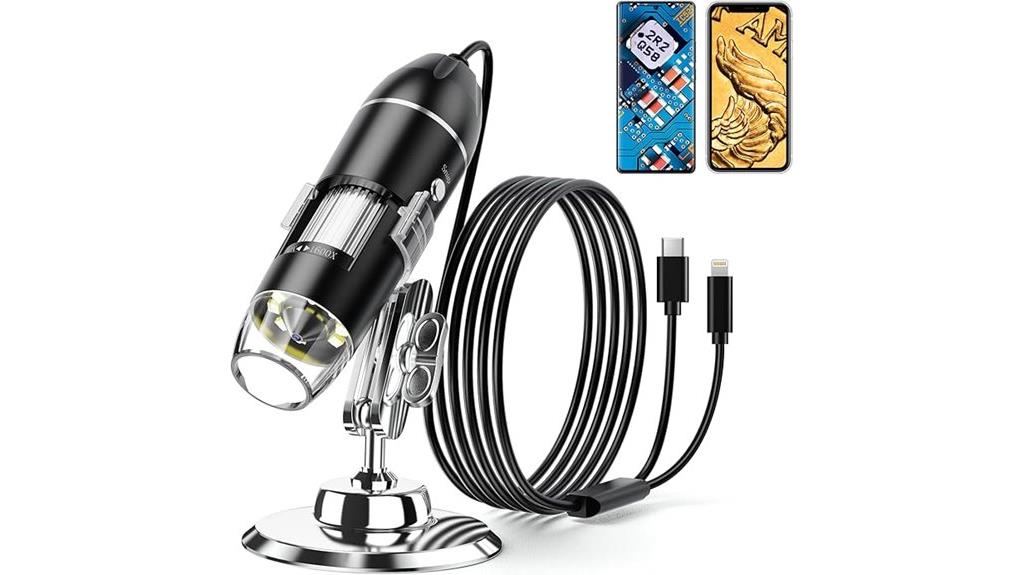
The Digital Microscope, 50X-1600X Portable USB Microscope with Adjustable Stand, is ideal for hobbyists, students, and professionals who need a versatile tool for detailed fiber analysis. Its lightweight design (just 5.3 ounces) and compact size make it easy to carry and set up anywhere. It connects seamlessly to iOS and Android devices via USB, with an adjustable stand and universal bracket for flexible viewing angles. The 2.7MP camera delivers sharp images at up to 1920*1440 resolution across a broad magnification range. While user experiences vary, its portability and high-resolution imaging make it a practical choice for on-the-go fiber examination.
Best For: hobbyists, students, and professionals seeking a portable, high-resolution digital microscope for detailed fiber or small object analysis.
Pros:
- Compact and lightweight design for easy portability and on-the-go use
- Supports both iOS and Android devices with seamless USB connectivity
- High-resolution 2.7MP camera with up to 1920*1440 image clarity and adjustable magnification
Cons:
- Some users report difficulties with focusing and stability during use
- Image quality and magnification levels may not meet all expectations, especially at higher zooms
- App permissions and media ownership issues can affect user experience
T TAKMLY Portable Digital Microscope with Light and 2.0-inch Screen
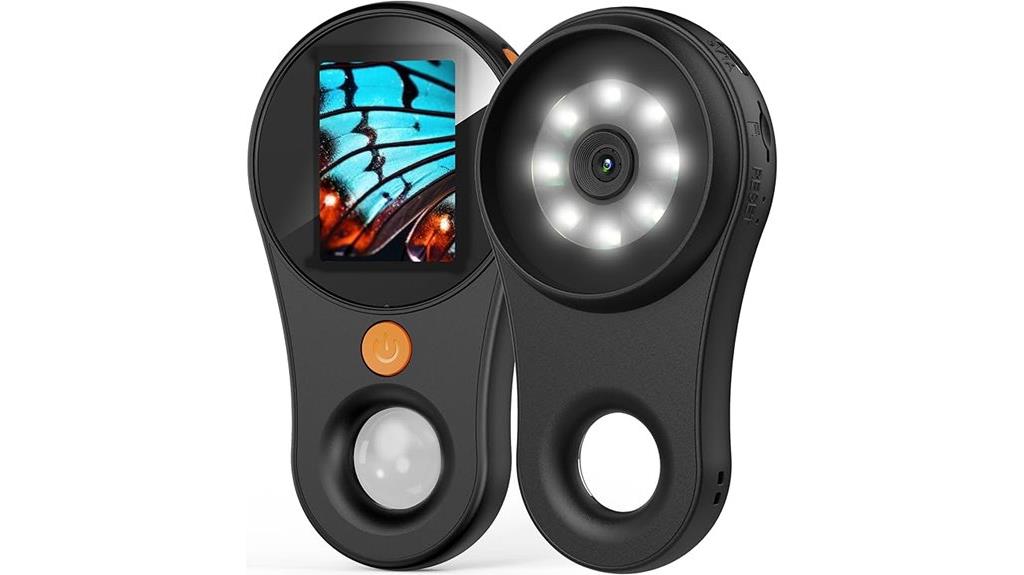
Designed for hobbyists, students, and outdoor explorers, the T TAKMLY Portable Digital Microscope with Light and a 2.0-inch screen stands out with its compact size and user-friendly features. Its 2.0-inch IPS color display provides real-time viewing, photo capture, and video recording with 1920x1080P resolution and up to 500x magnification. Equipped with 8 adjustable LED lights, it offers bright illumination even in dark conditions. Its small, lightweight design makes it perfect for fieldwork and casual exploration. Compatible with Windows and Mac, it connects via USB-C for easy file management and larger screen viewing, making microscopic observation simple and accessible.
Best For: hobbyists, students, and outdoor explorers seeking a portable, easy-to-use digital microscope for casual microscopic observation and educational purposes.
Pros:
- Compact and lightweight design, ideal for field use and on-the-go exploration
- High-quality 1920x1080P resolution with 500x magnification for clear images
- Adjustable LED lighting ensures bright, natural illumination in dark environments
Cons:
- Focus can be challenging; blurry images may occur if not used properly
- Limited photo download options; images can only be deleted from the device’s screen
- Some users experience software compatibility issues with MacBooks and minor quality concerns
LCD Digital Microscope with 4.3-Inch 1080P 10MP Camera and Wireless USB Connection
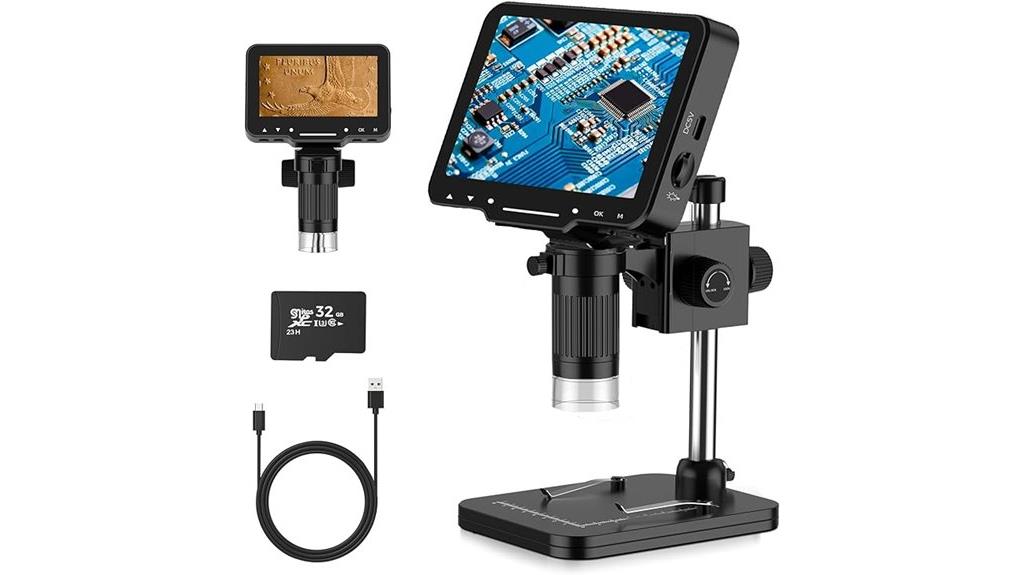
If you’re looking for a portable and easy-to-use microscope for detailed fiber analysis, the LCD Digital Microscope with a 4.3-inch 1080P 10MP camera and wireless USB connection is an excellent choice. It features a high-definition LCD screen for clear viewing and records images and videos directly on a 32GB microSD card. With 50X to 1000X magnification, adjustable LED lighting, and simple focus control, it’s versatile for inspecting fibers, jewelry, or electronics. Its rechargeable battery provides 4–5 hours of portable use, and wireless connectivity allows flexible observation anywhere, making it perfect for fieldwork and education.
Best For: hobbyists, educators, and field researchers needing portable, high-resolution microscopic observation for fibers, jewelry, electronics, and educational exploration.
Pros:
- High-definition 4.3-inch LCD screen with clear, detailed viewing
- Wireless USB connection for flexible, cable-free operation in various environments
- Long-lasting rechargeable battery providing 4-5 hours of portable use
Cons:
- Not suitable for medical or cellular analysis purposes
- Requires microSD card for image and video storage, which may need to be purchased separately
- Focus adjustment relies on manual rotation, which may require some practice for precision
Jonard Tools FIM-400 Fiber Optic Inspection Microscope
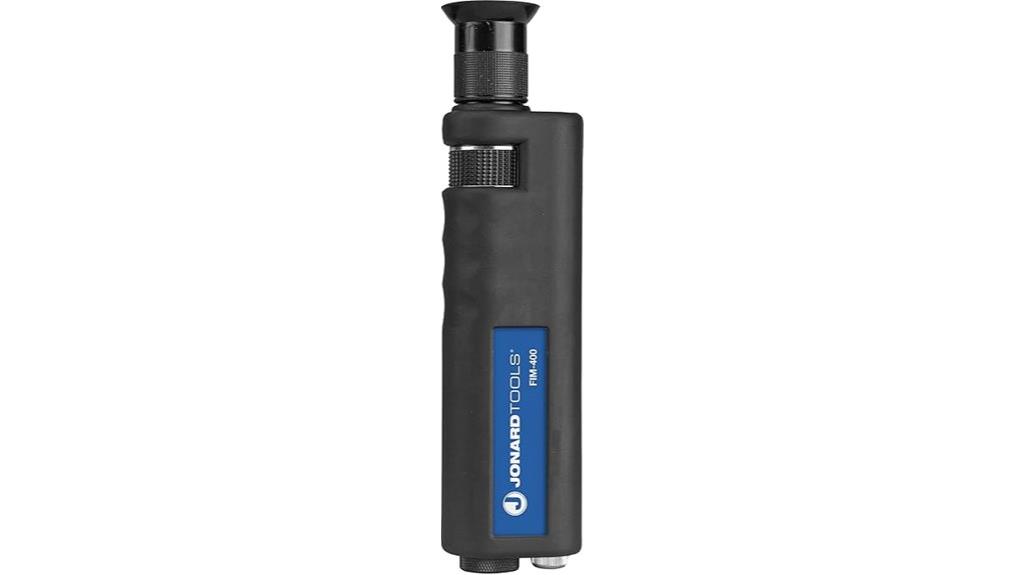
For professionals and enthusiasts seeking reliable fiber inspection, the Jonard Tools FIM-400 Fiber Optic Inspection Microscope stands out with its impressive 400x magnification and achromatic lens that deliver sharp, detailed images. It includes adapters for various fiber connectors, a focus wheel for fine adjustments, and coaxial illumination for clear viewing. The LED light provides extended battery life, and the device is built for durability and portability, making it ideal for on-the-go inspections. While some users find 400x a bit high for full fiber end viewing, the microscope’s clarity and ease of use make it a valuable tool for both beginners and experts.
Best For: Professionals and enthusiasts seeking a durable, high-magnification fiber optic inspection tool for detailed and reliable fiber end analysis.
Pros:
- Provides sharp, detailed images with 400x magnification and achromatic lens.
- Includes versatile adapters compatible with most fiber connector types.
- Durable construction with LED illumination for extended battery life and portability.
Cons:
- 400x magnification can be too high for full fiber end viewing; 200x may be more practical.
- Focus adjustment may be challenging initially and require practice.
- Additional tips are not sold separately, limiting customization for specific connector sizes.
Handheld Digital Microscope with 2.0 Inch IPS Screen
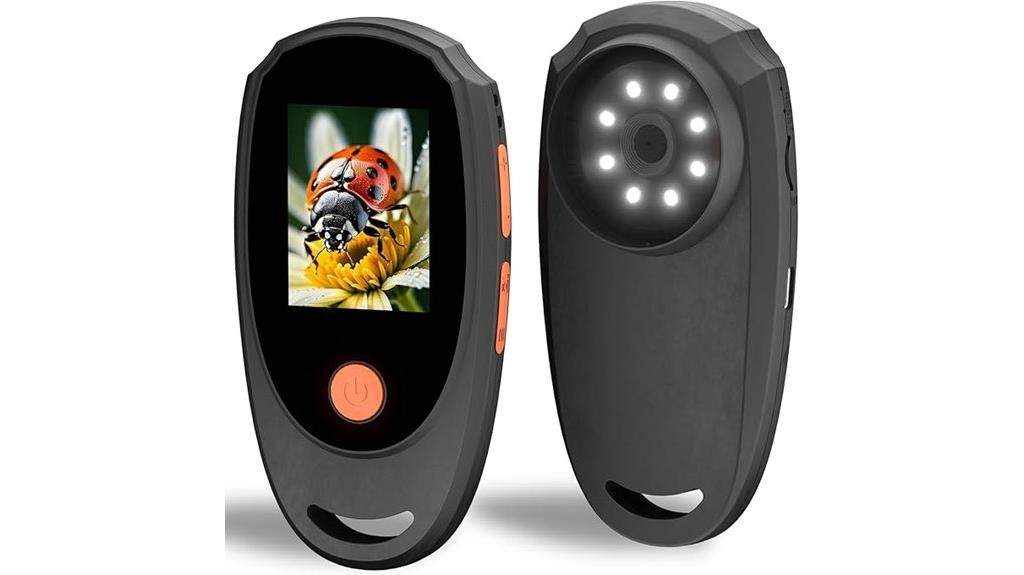
The Handheld Digital Microscope with a 2.0-inch IPS screen stands out as an ideal choice for hobbyists, students, and educators seeking a portable, easy-to-use device for inspecting fibers and other small objects. Its compact design (just over 4 inches long and weighing only 96 grams) makes it perfect for outdoor use, travel, or home. With 500x magnification, fixed and ultra-macro focus modes, and bright LED lighting, I can capture sharp images and videos easily. Connecting via Type-C to a PC or Mac, I enjoy larger viewing and file management. It’s versatile, lightweight, and perfect for educational, hobbyist, or fieldwork applications.
Best For: hobbyists, students, and educators seeking a portable, easy-to-use digital microscope for inspecting small objects and learning about science.
Pros:
- Compact and lightweight design makes it highly portable for outdoor, travel, or home use
- 500x magnification with fixed and ultra-macro focus modes provides clear, detailed images of various objects
- Bright LED lighting ensures good visibility even in dark environments, reducing eye strain
Cons:
- Fixed-focus mode not suitable for PCB soldering or detailed electronic work
- Photos stored internally cannot be downloaded directly, only deleted to free space
- Limited zoom strength prevents use for single-cell or highly detailed microscopic observation
TOMLOV DM9B 7 Digital Microscope
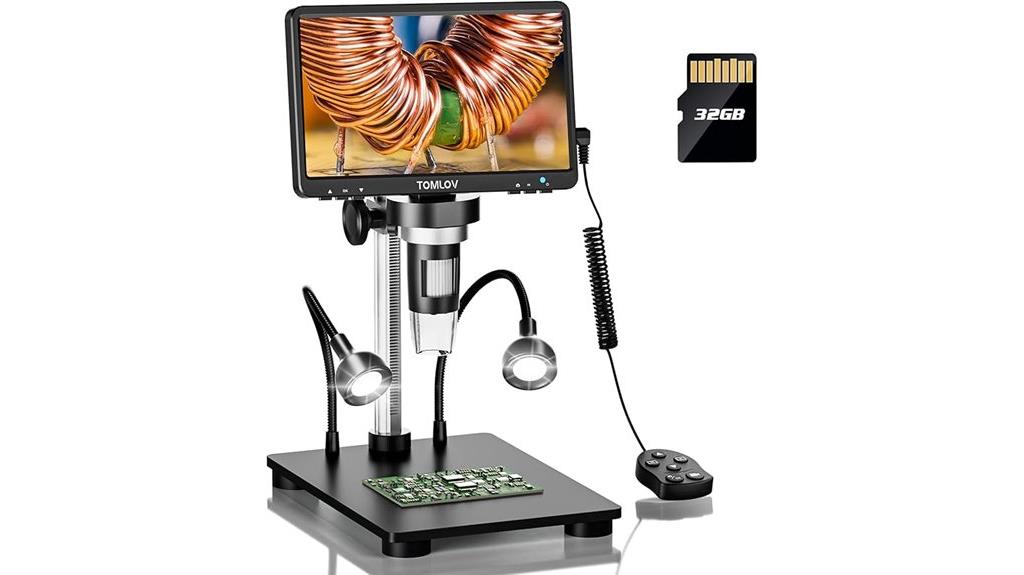
The TOMLOV DM9B 7 Digital Microscope stands out with its large 7-inch rotatable FHD screen, making it ideal for users who want a clear, detailed view without constantly switching between screens or devices. Its 12MP ultra-precise focusing camera delivers 1080P high-definition images, while adjustable viewing angles enhance flexibility. The black base minimizes reflections, ensuring accurate observations. Built with durable aluminum alloy, it’s perfect for micro soldering and PCB repairs. With up to 1200X magnification and multiple LED lights, it provides excellent illumination. Plus, its USB connection allows easy PC viewing, saving images and videos seamlessly for analysis and sharing.
Best For: hobbyists, students, and professionals seeking detailed microscopic observation for tasks like micro soldering, PCB repairs, and educational demonstrations.
Pros:
- Large 7-inch rotatable FHD screen offers clear, detailed visuals without the need for external devices
- High magnification range up to 1200X with 12MP camera ensures precise and sharp imaging
- Durable metal construction and adjustable lighting provide reliable performance during detailed work
Cons:
- May be relatively heavy due to solid metal build, impacting portability
- Requires USB connection to a PC for larger screen viewing, limiting use in standalone mode
- The extensive features might have a learning curve for beginners unfamiliar with digital microscopes
NICE-POWER Digital Microscope Camera (13MP, 1080P)
https://m.media-amazon.com/images/I/61wBoXopx+L._AC_SX679_.jpg
If you’re seeking a versatile digital microscope capable of detailed fiber inspection, the NICE-POWER Digital Microscope Camera stands out with its impressive 13MP 1080P HD imaging. It offers HDMI and VGA outputs, a 150X zoom C-mount lens, and a working distance up to 1000mm, making it ideal for examining tiny fibers, electronics, and coins. The bright LED ring light ensures clear images even in low light, while the adjustable stand provides stability. Although it lacks USB support, it’s praised for sharp image quality, responsive controls, and ease of use. This makes it a solid choice for hobbyists and professionals needing high-resolution visuals for precise analysis.
Best For: hobbyists, electronics repair professionals, and detailed inspection enthusiasts needing high-resolution imaging of small objects.
Pros:
- Sharp 13MP 1080P HD image quality with bright LED illumination for clear detailed visuals
- Versatile 150X zoom with adjustable magnification and long working distance up to 1000mm
- Easy to connect to external monitors via HDMI or VGA, with responsive controls and stable stand
Cons:
- Lacks USB and SD card support, requiring additional adapters for video recording
- Remote control does not include batteries and the menu defaults to Chinese, needing language adjustment
- Focus can be challenging due to the weight of the assembly and movement of the adjustable stand
Elikliv EDM9 Max Digital Microscope with 20MP and 1500X Zoom
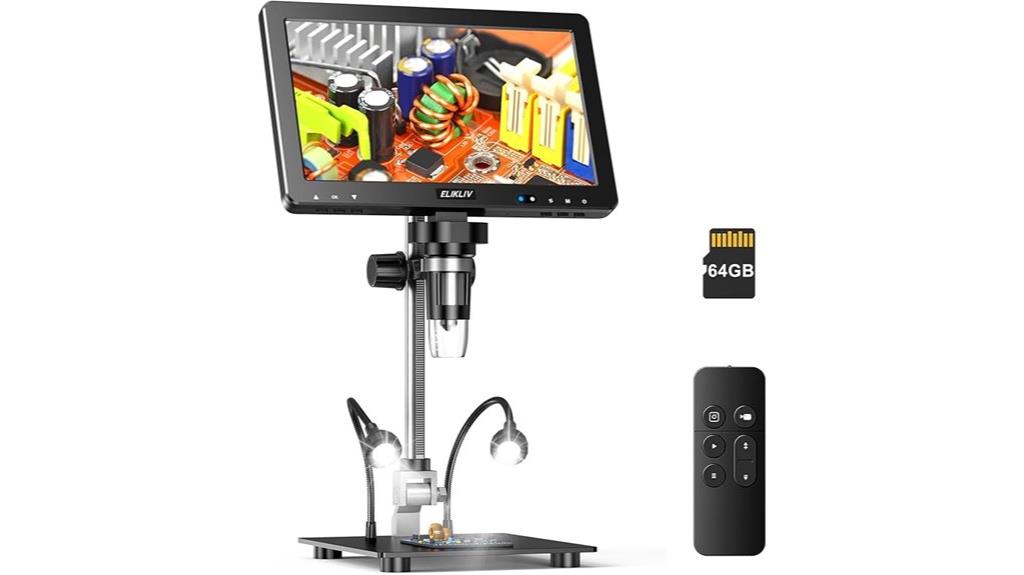
For those seeking detailed fiber inspections with exceptional clarity, the Elikliv EDM9 Max Digital Microscope stands out thanks to its impressive 20MP camera and 1500X zoom. Its 10.1-inch HD IPS screen delivers sharp images and smooth 1080P videos, making it easy to examine tiny fibers. The microscope supports real-time HDMI and USB output, allowing connection to larger screens for presentations or collaborative analysis. With adjustable dual lighting—8 LED lights and 2 gooseneck lamps—it guarantees ideal illumination. The device also features built-in storage, one-button capture, and audio narration, making fiber inspection precise, efficient, and user-friendly.
Best For: hobbyists, researchers, and professionals requiring detailed fiber inspections with high clarity and precise control.
Pros:
- Exceptional 20MP camera and 1500X zoom provide clear, detailed images of tiny fibers.
- Large 10.1-inch HD IPS screen offers comfortable viewing and easy analysis.
- Supports real-time HDMI and USB output for sharing and collaborative work.
Cons:
- Durability may be a concern with frequent heavy use.
- Missing SD card in some packages can hinder immediate storage options.
- Heavier weight (4.38 pounds) might affect portability for on-the-go inspections.
USB Digital Microscope with 50x-1600x Magnification, HD 1440P, 8 LED Lights, Compatible with iOS & Android Devices
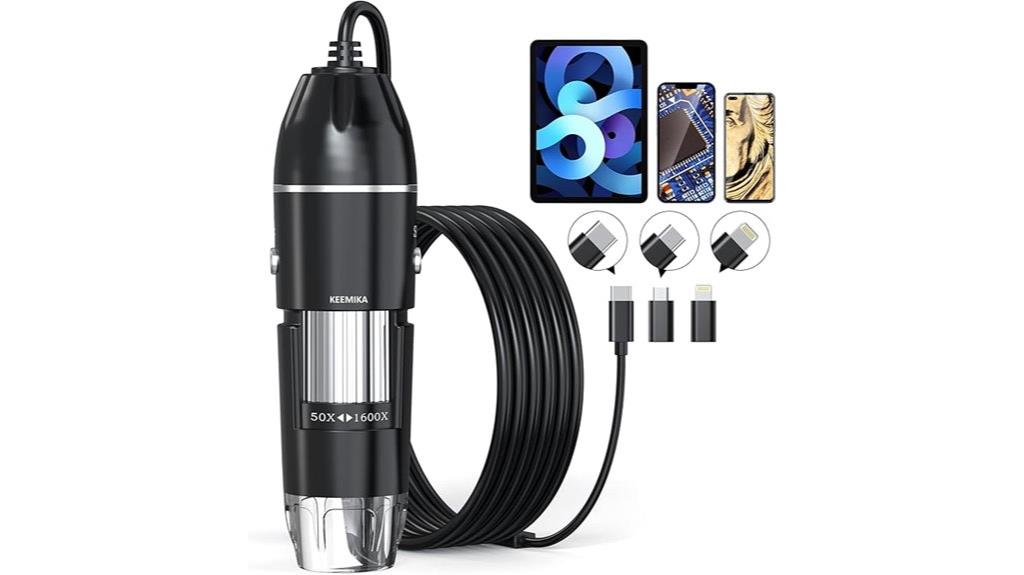
Those seeking a portable and versatile microscope will find the USB Digital Microscope with 50x-1600x magnification an excellent choice, especially when working with fibers and tiny specimens. It features a 2MP camera with 1440P resolution, capturing sharp images and videos. With 8 adjustable LED lights, it provides clear visibility even in dark environments. Compact and lightweight at just over 3 ounces, it connects directly to iOS and Android devices via adapters, no WiFi needed. Ideal for hobbyists, collectors, and professionals, it’s perfect for detailed inspection of small objects like electronic components, jewelry, or biological samples.
Best For: hobbyists, collectors, and professionals seeking a portable, high-resolution digital microscope for detailed inspection of small objects and specimens.
Pros:
- Clear 1440P HD images and videos with up to 1600x magnification for detailed viewing.
- Compact, lightweight design with a USB Type-C cable and adapters, making it highly portable.
- Equipped with 8 adjustable LED lights to ensure proper illumination in dark or low-light environments.
Cons:
- App functionality issues such as long shutter delay, loud clicking sounds, and privacy concerns.
- Some users report durability problems, particularly with the Lightning connector.
- Media files are saved within the app, requiring screenshots or screen recordings to export images and videos.
Factors to Consider When Choosing an HD Digital Microscope for Fibers

When choosing an HD digital microscope for fibers, I consider key factors like magnification range and image resolution to guarantee I see fine details clearly. Illumination quality and compatibility with different fiber types are also vital for accurate analysis. Finally, ease of focus adjustment helps me quickly get sharp images without hassle.
Magnification Range Options
Choosing the right magnification range is crucial for effective fiber inspection with an HD digital microscope. Typically, a range from 100x to 400x works well for detailed analysis of fiber end faces and connectors. Lower magnifications, like 50x to 100x, are ideal for quick overviews, helping identify major issues such as dirt or damage. For more detailed examination, higher magnifications—around 1000x or more—are necessary to spot microscopic debris or surface scratches. Many microscopes offer adjustable magnification, giving flexibility for various inspection tasks. Selecting a model with a broad, precise magnification range ensures you can perform both general assessments and detailed defect analysis without switching equipment. This versatility is essential for thorough fiber inspection and maintaining peak performance.
Illumination Quality Levels
High-quality illumination is essential for accurate fiber inspection, as it reveals surface details and contaminants that might otherwise go unnoticed. Adjustable LED brightness allows me to tailor lighting to different fiber conditions, ensuring clear visibility in various environments. Consistent, bright lighting minimizes shadows and glare, which is crucial for precise analysis. Many microscopes offer multiple lighting modes, like diffuse or focused LEDs, to highlight surface textures and contaminants effectively. A well-designed illumination system provides uniform light distribution, preventing uneven brightness that can obscure fine features. Brightness control capabilities are vital, enabling me to customize illumination levels for specific fiber types and inspection needs. Overall, a flexible, high-quality illumination system significantly enhances the accuracy and efficiency of fiber inspections.
Compatibility With Fiber Types
Selecting an HD digital microscope that matches your fiber types requires careful attention to compatibility features. First, verify the microscope includes adapters, like 2.5mm or 1.25mm interfaces, to fit various connector types such as SC, LC, FC, and ST. It’s also important that the device supports inspection of both fiber end-faces and ferrules across single-mode and multi-mode fibers. Check that the optical system delivers clear, razor-sharp images for different fiber diameters and standards. Adequate illumination is essential for illuminating various fiber surfaces and end-faces, ensuring accurate inspections. If your network includes specialized connectors like MPO or MTP, confirm the microscope’s compatibility with these as well. Proper compatibility guarantees precise analysis and minimizes the need for additional adapters or equipment.
Image Resolution Capabilities
When evaluating an HD digital microscope for fiber inspection, the resolution it offers plays a pivotal role in the quality of your analysis. Higher resolutions, like 12MP or above, deliver clearer, more detailed images of fiber end-faces, making it easier to spot defects or contaminants. A resolution of 1080P or higher ensures sharp visuals that reveal even the tiniest issues, indispensable for accurate inspections. The effective pixel count directly affects your ability to zoom in without losing clarity, which is essential for detailed analysis. Many high-resolution models support real-time image and video capture, streamlining documentation and comparison. However, balancing resolution with frame rate and sensor quality is key to maintaining ideal image detail during continuous fiber inspections.
Ease of Focus Adjustment
To achieve sharp, detailed images of fiber end-faces, it’s essential that an HD digital microscope features smooth and precise focus adjustment mechanisms. I look for microscopes with dedicated focus wheels or rings that allow fine-tuning without applying excessive force. An easy-to-operate focus control speeds up the inspection process and guarantees accurate results, especially when examining different fiber types or varying distances. A broad focus range or macro focus capability is also critical, as it lets me capture clear images at different depths and positions. Clear focus adjustment is fundamental for detecting defects and analyzing fiber quality reliably. When choosing a microscope, I prioritize models that offer intuitive controls, smooth operation, and flexibility to adapt to various fiber inspection needs.
Portability and Power Source
Portability and power source are essential factors when choosing an HD digital microscope for fiber inspection. I look for a lightweight, compact device that’s easy to carry between sites, especially if I need to work in the field. The power options matter too—rechargeable batteries give me independence from outlets, while external adapters ensure continuous power during extended sessions. I check the battery life to make sure it can handle my inspection needs without frequent recharging. Some microscopes come with built-in rechargeable batteries, offering convenience, while others require disposable batteries, which can be less practical. Quick recharging capability and reliable operation in environments with limited electrical access are key features I prioritize. These factors help ensure my microscope is always ready when I need it most.
Frequently Asked Questions
How Do Digital Microscopes Compare to Traditional Optical Microscopes?
Digital microscopes offer a lot of advantages over traditional optical ones. I find they’re more convenient because I can view images on a screen, which makes sharing and analyzing easier. They often come with high-definition cameras that provide clearer images and can save data for later review. While traditional microscopes are reliable and don’t need power, digital ones add versatility and modern features that improve my research and inspection work.
What Is the Optimal Magnification Range for Fiber Analysis?
Did you know that most fiber analysis requires magnifications between 100x and 500x? For ideal results, I recommend a range of 200x to 400x. This level allows detailed viewing of fiber structures without losing context. Higher magnifications can be useful for surface details, but too much can make it hard to see the entire fiber. Balancing magnification ensures clear, precise analysis every time.
Are Digital Microscopes Suitable for Fieldwork or Only Laboratory Use?
Digital microscopes are actually great for fieldwork because they’re portable and easy to use outside the lab. I’ve used them in various environments, and their quick image capture helps me analyze fibers on the spot. While they might not have the same power as some lab microscopes, I find their convenience and clarity perfect for field inspections. They’re definitely versatile tools for both in-lab and on-site fiber analysis.
How Important Is Image Resolution for Fiber Inspection Accuracy?
Image resolution is vital for fiber inspection accuracy because it determines how clearly I can see the fiber details. Higher resolution means I spot even tiny defects or inconsistencies, ensuring precise analysis. If the resolution’s too low, I risk missing flaws that could compromise quality. So, for accurate fiber inspection, I always prioritize microscopes with excellent image resolution to get the most reliable results.
What Maintenance Is Required to Keep the Microscope in Optimal Condition?
Ever wondered what keeps my microscope performing at peak? Regular cleaning is key—gently wipe lenses with specific wipes, avoid touching glass surfaces, and keep the device dust-free. Check the focus and lighting systems periodically, and store it in a dry, safe place. These simple steps prevent damage and guarantee crisp images, so your fiber analysis remains precise and reliable day after day. Trust me, maintenance makes all the difference.
Conclusion
So, after all this, you’d think picking the perfect HD microscope is a breeze. But with so many options promising crystal-clear images and precise analysis, it’s almost poetic how one might still feel lost in the details. Irony? The best tool for fiber inspection might just be the one that seems simplest—yet packs the most power. Ultimately, the right choice isn’t about perfection; it’s about finding what works best for you, flaws and all.

